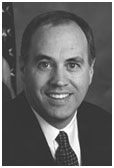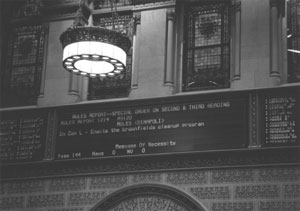|

"By cleaning up brownfield sites and refinancing the stateís Superfund program,
not only will environmental threats be removed from communities throughout the state,
but local economies will also be revitalized. This is a momentous agreement that
will provide tremendous benefits for generations to come."
 Assemblyman Assemblyman
Thomas P. DiNapoli, Chair
Assembly Committee on
Environmental Conservation
|
|
Historic Agreement Reached on Superfund and Brownfields Legislation
In the final hours of the 2003 legislative session, the Assembly passed legislation
(A.9120) to refinance the Superfund Program and establish
the Brownfield Cleanup Program (BCP). The Senate has expressed a commitment to return in
September to pass their matching bill (S.5702) and the
Governor has indicated he intends to sign it.
Superfund Program
New York established the nationís first Superfund Program in 1979 in response to the
tragedy at Love Canal. The 1986 Environmental Quality Bond Act (EQBA) provided $1.2
billion in funding and resulted in the remediation of more than 800 contaminated sites.
However, monies from the EQBA were fully committed in 2001, with hundreds of hazardous
waste sites still in need of investigation and remediation. This bill refinances the
Superfund Program with $120 million in annual bonding while maintaining the historic
50/50 industry/public contribution to finance such bonds.
This legislation also expands the scope of the Superfund Program to include hazardous
substances sites, which have historically been excluded. Other provisions establish
liability exemptions for municipalities, fiduciaries and lenders; create a Technical
Assistance Grant program for community groups; and strengthen the enforcement of
institutional and engineering controls.
Brownfield Cleanup Program (BCP)
Brownfields are a drag on local economies across New York and can pose a public health
risk if not cleaned up. The new BCP establishes a preference for permanence and a
framework to remediate these contaminated sites utilizing the nationís toughest cleanup
standards, while providing developers, municipalities and community-based organizations
with a more predictable and speedy process, financial incentives and liability relief.
The bill requires all remedies to protect groundwater for its classified use and to
protect sensitive populations, including children. At all sites, concentrated sources
of contamination must be removed or treated to the greatest extent feasible. The level of
risk associated with the cleanup standard for any individual contaminant listed in the
look-up tables may not exceed one-in-one-million for cancer or a hazard index of one for
non-cancer endpoints.
The program addresses the remediation of contaminated groundwater both on-site and
off-site. BCP participants, who are responsible for contamination, must take all feasible
measures to control plumes both on-site and off-site, while volunteers (parties not
responsible for the contamination) would be relieved from responsibility for contamination
that has migrated off-site. Where it is a "significant threat site" that is
being cleaned up by a volunteer, DEC will handle the off-site remediation.
Brownfield Cleanup Incentives
The legislation provides financial, legal and programmatic incentives to encourage the
remediation and redevelopment of brownfield sites. These incentives include:
-
Tax credits, valued at an estimated $135 million annually, including tax credits for the
remediation and redevelopment of sites, with higher value credits for those who perform
unrestricted cleanups;
-
State liability releases for the successful completion of the program;
-
1996 Clean Water/Clean Air Bond Act reforms that allow municipalities to receive up to
90% of eligible cleanup costs from the state, and to keep any profits realized upon the
sale of a site following remediation. More than $168 million dollars is still available
under this program;
-
Brownfield Opportunity Area (BOA) grants will be available to community based
organizations for neighborhood pre-planning, planning, and site assessment activities.
These grants will come from the $15 million in funding to support brownfields programs.
Once BOA plans are adopted, cleanups and redevelopment in conformance with such plans
would be given the highest priority for funding under the Bond Act.
Groundwater Protection and Remediation Program
The bill establishes a statewide Groundwater Protection and Remediation Program that
requires DEC to develop a strategy to address the long-term remediation of groundwater
contamination. Effective administration of the program will be enhanced by the
establishment of a Geographic Information System (GIS) that will provide a centralized,
comprehensive and publicly accessible accounting of contaminated sites across the state.
Tremendous Benefits for the State
By cleaning up brownfield sites and refinancing the stateís Superfund program, not only
will environmental threats be removed from communities throughout the state, but local
economies will also be revitalized. This is a momentous agreement that will provide
tremendous benefits for generations to come.
|
